Introduction
Our group decided to cross breed wild females with vestigial male fruit flies (Drosophilia melanogaster). A vestigial fly has genetically mutated wings. They have crumpled wings which prevent them from being able to fly properly. This mutation is related to the temperature at which the pupas hatch in. We chose this type of cross to prove if wild or vestigial wings were dominant among fruit flies. Our original hypothesis was that vestigial wings are autosomal recessive.
Fruit Fly Characteristics
Phylum: Anthropoda
Class: Insecta
Order: Diptera
Family: Drosophilidae
Life Cycle: There are four stages in a Fruit Fly's life.
Larva: One day after the egg is laid, the larva hatches. The larva molts twice until it darkens and harden into a "puparium." This stage lasts approximately 8 days.
Pupa: The puparium undergoes a metamorphosis. The pupa will darken right before the emergence of the Fruit Fly. One day prior to emergence, the folded wings appear as dark elliptical bodies below te surface and the pigment of the eye becomes visible through the Pupa. This stage lasts approximately 6 days.
Adult: The adult then emerges by forcing its way through the anterior of the puparium. At first the fly is light in color with the wings unexpanded, and the abdomen long. In a few hours, the wings are expanded, the abdomen rounds and the color darkens, turning the flies into the final adult stage. A fly will live for several weeks usually.
Phenotypes
- Wild type flies have fully open wings and there bodies are normal.
- Vestigial type flies have wings that are crumpled and unopen but the body of the fly is still normal.

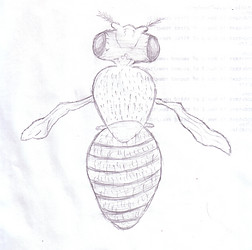
Image # 12025 if you want to move it. © 2006 fruitflyblue2

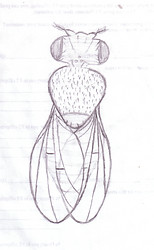
Image #12026 if you want to move it. © 2006 fruitflyblue2
Group Life Cycle Log
Date | Observations |
| 2/27/06 | Flies expanded to new cultures |
| 3/3/06 | No sign of larva * Medium dry- Add water |
| 3/6/06 | Small black dot moving up, down and forward. Looking closer can see long thing clear body all moving, burowing, and eating. |
| 3/7/06 | there are still lots of pupae on the sides of the tube and many larvae in the medium some are crawling up on to the sides and slowing down become pupa only 5 or 6 actuual adult flys in the vial |
| 3/9/06 | there have been very few changes in the vial. though the larvae are congragating near the top of the medium |
| 3/10/06 | Almost no changes in the vial. the larva are still near the top of the medium. no pupae look close to hatching |
| 3/13/06 | 50% of the larvae are about ready to hatch. other than that everything is normal. larva is still at top of the medium pupa |
| 3/14/06 | the flies slept adults only |
| 3/16/06 | P1 cross there are no larvae or eggs visable one male has died one female is stuck |
| 3/17/06 | there may be larvae in vial 1 there is no evidence of larva in vial 2 but we may be missing them |
| 3/20/06 | There is definite larval activity in vial 1, they are moving around in the medium. All the flies are still alive. In vial 2, there is some larva activity but not as much as in vial 1. The fly that was trapped in the medium has died (appears to be a male vg). |
| 3/21/06 | There are lots of visable larvae in both containers begining to crawl up the sides of the vial |
| 3/23/06 | Less larvae, the majority of it has become pupae. They are continuing to crawl up the sides. Other than that, things are relatively the same. |
| 3/24/06 | There are many pupa on the walls. Lavae are still in the medium. |
| 3/26/06 | The pupae have hatched. lots of flies only one visual vg but might be a mistake |
| 3/27/06 | No significant change except for more flies hatching there are obviously vg and wild type wings in both viles but there seem to be more wild type just at a quick glance |
| 3/30/06 | It seems most ot the flies have hatched |
| 3/31/06 | there is a black crusty layer in vial 1. still a bunch of unhatched pupae in both vials |
| 4/3/06 | There have been three deaths in vial one but none in the second vial. The dead ones look like they are all males. Medium appers ok |
| 4/6/06 | There are larvae now and almost all the flies are alive |
| 4/7/06 | There are larvae in both viles. vile 2 has 3 pupae and in vial 1 there are even more |
| 4/17/06 | There seems to be a lot more males than felmales in vial 2 |
| 4/18/06 | The flies that got stuck in vial one are free from the medium, and it seems as if more have hatch in both vials |
| 4/21/06 | There are many flies in vial 2. Vial 2 definetly has larva and some pupa. Vial seems to have very little or no larva. There are some pupae |
| 4/24/06 | Both vials have good amounts of flies; but mediums are begining to get very small |
| 4/25/06 | There are more flies in both vials. There is still a lot of larvae in the medium. The medium has shrunk considerably. |
Sexing The Flies
Anesthetizing the Flies:
You will need to anesthetize the flies so that you can handle them with out chance of them escaping.
- Tap the flies down on the table to clear them from around the plug
- Have Fly Nap already on wand. Push plug aside and slide wand into container, without touching the plug or the sides of the container
- Allow the flies to be exposed to the FlyNap for approximately 2-3 minutes
- Remove wand from container and pour flies out
Sexing of the Flies:
Remember females will have a light exterior abdomen while males will have the darker exterior abdomen
- Use a piece of paper or index card to sort flies into piles of males and females,
- Turn flies onto their backs, to allow more accurate sexing. - If sexing for virgin females, discard females with enlarged abdomens.
F1 Predictions
If the mutation vestigial wings(vg) is dominant then they will be 100% vestigial wings for the phenotype and for the genotype they will be 100% vg+
| vg | vg | |
| + | vg+ | vg+ |
| + | vg+ | vg+ |
If wild is dominant and vestigial is reccessive then 100% of the phenotypes will be wild and 100% of the genotypes will be +vg
| + | + | |
| vg | +vg | +vg |
| vg | +vg | +vg |
Outcomes for F1 Cross
Both Vial 1 & 2 P Cross= wild wing female X vestigial male
F1 Male Phenotype= wild wing (two possible vg in vial 1)
Based on predictions, the likely Genotype/s for F1 males= Heterozygous wild male(+/vg)
Both Vial 1 & 2 P Cross= wild wing female X vestigial wing male
F1 Female Phenotype= wild wing
Based on predictions, the likely Genotype/s for F1 females= Heterozygous wild female(+/vg)
And thus, based on our data, we conclude that the inheritance of the mutation is Autosomal Recessive.
F2 Predictions
In vial 1 we crossed F1 wild wing male (genotype ,vg) with wild wing females (genotype +vg). We were expecting 75% wild wing and 25% vestigial wing for the phenotypes of the offsprings. The genotypes that are expecting will be 25% homozygous wild wing (++), 25% homozygous vestigial wing (vg vg) and 50% heterozygous wild wing (+vg). In vial2 we expect the same results because both vials have the same crosses.
| + | vg | |
| + | ++ | +vg |
| vg | +g | vg vg |
F2 Outcomes
VIAL 1
| Date | Female Wild | Male Wild | Female Vestigal | Male Vestigial |
| 4/17/06 | 22 | 10 | 8 | 0 |
| 4/19/06 | 9 | 9 | 5 | 4 |
| 4/21/06 | did | not | count | this day |
| 4/24/06 | 32 | 43 | 1 | 0 |
| 4/25/06 | 14 | 8 | 1 | 1 |
Overall Total 167 | 77 | 70 | 15 | 5 |
| Total Wild | 147 | Total Vg | 20 |
VIAL 2
| Date | Female Wild | Male Wild | Female Vestigial | Male Vestigial |
| 4/17/06 | 83 | 101 | 1 | 2 |
| 4/19/06 | 26 | 19 | 0 | 1 |
| 4/21/06 | 25 | 20 | 0 | 1 |
| 4/24/06 | 16 | 11 | 0 | 0 |
| 4/25/06 | 16 | 30 | 0 | 0 |
Overall Total 351 | 166 | 181 | 1 | 3 |
| Total Wild | 347 | Total Vg | 4 |
Observed versus expected
| Vial 1 | ||||||
| Phenotype | Observed | Expected | (O-E) | (0-E)/E | X100 | %Error |
| Wild wing | 147 | 125.25 | 21.75 | 0.173652694 | 17.36526946 | 17.37% |
| Vestigial wing | 20 | 41.75 | 21.75 | 0.520958083 | 52.09580838 | 52.10% |
| Vial 2 | ||||||
| Phenotype | Observed | Expected | (O-E) | (0-E)/E | X100 | %Error |
| Wild wing | 347 | 263.25 | 83.75 | 0.318138651 | 31.81386515 | 31.81% |
| Vestigial wing | 4 | 87.75 | 83.75 | 0.954415954 | 95.44159544 | 95.44% |
Conclusion
The observed data was nowhere close to what we expected. Our original hypothesis was if the mutation vestigial is autosomal recessive in the P generation, then by the F generation the phenotype ratio will be 75%:25% (3:1). However, there was over a 50% error in Vial 1 with the vestigials and in Vial 2, there was a 95% error with the vestigial along with a 31% error with the wild wing. This is such a large error between the expected and what we observed, that we believe either our predictions were incorrect, or there was contamination. We are fairly sure that contanimation occurred in Vial 2, although we are unclear on Vial 1. Along with this, we also must consider the fact that some flies may have escaped or gotten stuck in the medium and we are unsure of the survival rate between vestigial and wild wing.
If we were to conduct this process again in a more in depth approach, the most accurate way to avoid errors would be to breed only one vestigial male with one wild female in seperate vials. We would do this with multiple pairs of flies and remove them from vials as soon as Pupa appeared. Then once the F1 emerged, we would seperate them into pairs with the flies from the same vial. By keeping an extensive chart of the parentage of the flies, we would be able to track any contamination. This way it would be more clear, even though it would mean using more supplies and logging more manhours to complete the project successfully.
Eulogy
Our flies have made a significant difference, even if one may not think so by just looking at them. They lived to teach us, and to better educate people as to make the big picture of the fly world a better place. You wouldn't think such small beings could make such a difference, but they have and they will forever be remembered. These heroic flies did not die in vain.
Not only did they give their lives to help all of their fellow flies in generations to come, but they also gave added perspective to a world where achievement is measured by quantity. They have shown us that no matter how small something or someone is, they can still make a difference, and it still matters. It always matters. And I, personally, have them to thank for opening my eyes even further to this rich perspective. Therefore, they have generously given me the ability to pass this perspective on to people and beings that I meet, giving them the ability to pass it on to the people they come in contact with.
And thus, in a chain reaction, these flies have changed the world.
 Click on an image to view larger version & data in a new window
Click on an image to view larger version & data in a new window 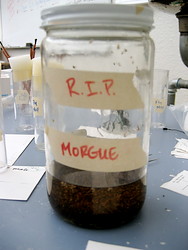

© 2006

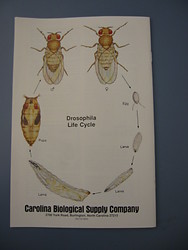
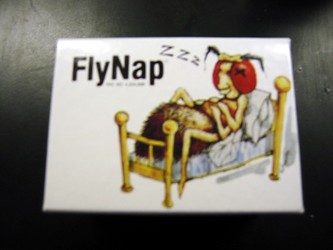
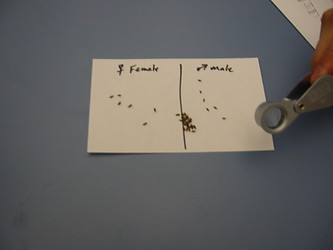


 Go to quick links
Go to quick search
Go to navigation for this section of the ToL site
Go to detailed links for the ToL site
Go to quick links
Go to quick search
Go to navigation for this section of the ToL site
Go to detailed links for the ToL site